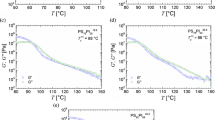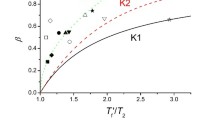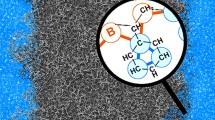Abstract
Polystyrenes with different concentrations of side groups with cyano groups were prepared and complex dielectric constants were measured in the range of the glass transition temperature and the frequency range of 10−2–107 Hz.
The GPC and DSC measurements showed that the molecular weight of these polystyrenes was about 10500 g/mole and the glass transition temperatures were 89.5°C for all samples.
The dielectric relaxation spectra obtained for the side group polystyrene labels and also the chain-end polystyrene labels prepared before [9] were analyzed to find out the degree of coupling of the chain-end and side-group labels with the cooperative reorientation of the polymeric matrix. The analysis of the spectra was carried out using the analysis method developed by Mansour and Stoll [6].
The results obtained showed that both end- and side-group labels are strongly coupled with the segmental reorientation and relax with relaxation times longer than that of the segments.
The value of Δlogf m = (logf m(label)) − logf m(matrix)) was obtained from the recently designed comparison diagram suggested by Mansour and Stoll [6, 14]. The value of Δlogf m depends on the label length in the case of chain-end labels.
It was surprising to find that the side groups relax slower than the segments by only 0.9 decades. These results obtained implied that the label relaxes through a multistep relaxation mechanism of the side and end groups and not through a diffusion mechanism of the whole chain. In addition, the effective lengths of the relaxing units were determined using the empirical equation obtained before in the case of rodlike molecules in polyisoprene [7].
Similar content being viewed by others
References
Springer H, Neuert R, Müller FD, Hinrichsen G (1983) Colloid Polym Sci 261:800
Fuhrmann J, Hennecke M (1989) Makromol Chem, Macromol Symp 26:209
Winkler G, Stoll B, Sautter E, Pechhold W (1980) Colloid Polym Sci 258:289
Bakule R, Heinrich W, Pechhold W, Stoll B (1986) Colloid Polym Sci 264:185
Mansour AA, Stoll B, Pechhold W (1992) Colloid Polym Sci 270:219
Mansour AA, Stoll B (1993) Colloid Polym Sci 271:834
Mansour AA, Stoll B (1994) Colloid Polym Sci 272:17
Hyde PD, Ediger MD (1990) J Chem Phys 92 (2): 1036
Mansour AA, Junge R, Stoll B, Pechhold W (1992) Colloid Polym Sci 270:325
Portugall M, Ringsdorff H, Zentel R (1982) Macromol Chem 183:2311
Heinrich W, Stoll B (1988) Colloid Polym Sci 78:37
Klingbiel RT, Genova DJ, Criswell TR, van Meter JP (1974) J Am Chem Soc 96(25):7651
Fröhlich H (1958) Theory of dielectrics, 2nd Ed, Oxford University Press, Oxford, UK
Mansour AA (1992) Thesis, University of Ulm, FRG
Mansour AA, Stoll B (1994) Colloid Polym Sci 272:25
Gnoth M (1993) Thesis, University of Ulm, FRG
Author information
Authors and Affiliations
Rights and permissions
About this article
Cite this article
Mansour, A.A., Happ, E., Wolf, T. et al. Dielectric relaxation of polystyrene with side-chain- and chain-end-labels. Colloid Polym Sci 272, 894–902 (1994). https://doi.org/10.1007/BF00658887
Received:
Accepted:
Issue Date:
DOI: https://doi.org/10.1007/BF00658887




